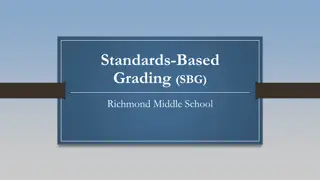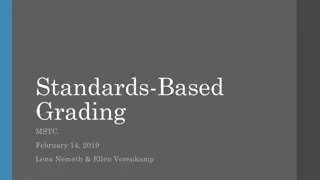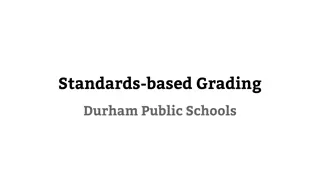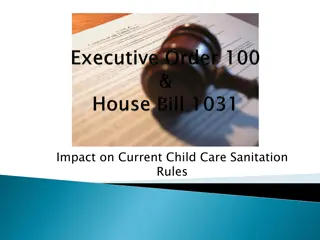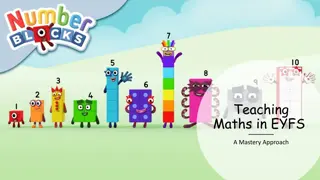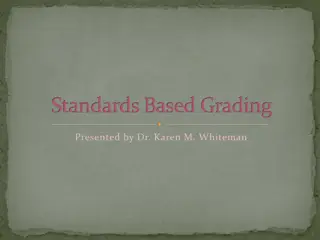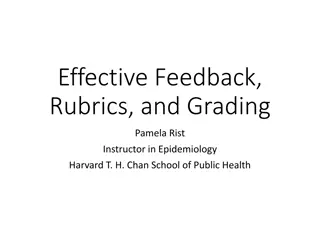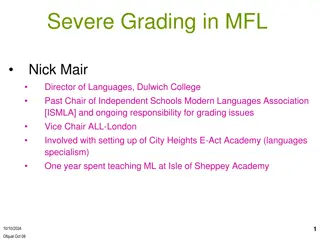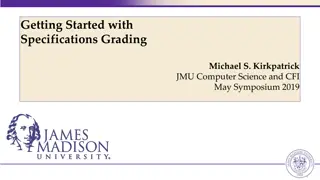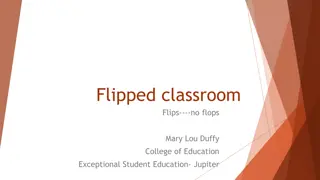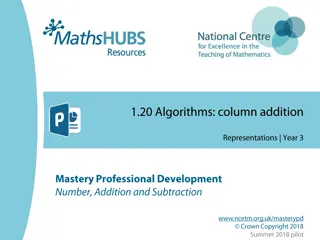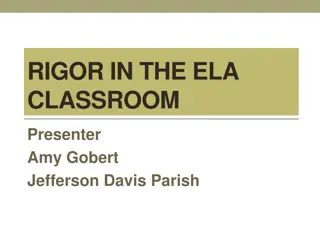Mastery-Based Grading in Modern Classrooms
Implementing a mastery-based grading system to enhance student engagement and self-pacing in a blended learning environment. The approach includes creating end-of-lesson assessments, developing policies for revision, and providing opportunities for reassessment to ensure mastery of standards and accurate academic evaluation.
Download Presentation

Please find below an Image/Link to download the presentation.
The content on the website is provided AS IS for your information and personal use only. It may not be sold, licensed, or shared on other websites without obtaining consent from the author.If you encounter any issues during the download, it is possible that the publisher has removed the file from their server.
You are allowed to download the files provided on this website for personal or commercial use, subject to the condition that they are used lawfully. All files are the property of their respective owners.
The content on the website is provided AS IS for your information and personal use only. It may not be sold, licensed, or shared on other websites without obtaining consent from the author.
E N D
Presentation Transcript
Modern Classroom Project Alyssa Preece Intermediate Science Teacher Duff Allen Central Elementary
Problem of Practice: Why MCP Student engagement Self-pacing for students Blended learning Time for small group instruction Time for one-on-one instruction Mastery of the standards True gauge of where students are academically
Step 1: Mastery Based Grading/Mastery Checks Step 2:Instructional Videos Steps of Modern Classroom Project Step 3: Self-pacing Plan Step 4: Learning Design Plan Step 5: Final Submission- 3 Complete lessons
What I was supposed to do: Create end-of-lesson assessments that efficiently & effectively measure understanding. Develop policies and procedures that support regular revision & reassessment of mastery. Step 1: Mastery Based Grading
Learning Objective for mastery check: I can identify and give examples of external plant structures that function to support survival, growth, behavior, and reproduction. (SGBR) 4-LS1-1 From Molecules to Organisms: Structures and Processes Step 1: Mastery Based Grading Construct an argument that plants and animals have internal and external structures that function to support survival, growth, behavior, and reproduction.
Students can attempt to demonstrate their mastery as many times as they like, until they prove understanding of the content. If a student does not show mastery after taking a mastery check (MC) then the student will be asked to show their guided notes and the practice work they have completed. I'm going to assume that students who do not pass the MC will not have done the guided notes/watched the video or given true effort on the practice work. If that is the case, the student will reattempt the guided notes or practice. They will then take the retake MC (alternative version) at my small group table after showing completed notes and practice work. If the student fails to pass the MC a second time, then I will do one-on-one or small group teaching of the content. Then an alternative MC will be administered. It may be that the student needs to verbalize the answer (use of Google Forms for MC and use of speech to text tech). Mastery Check Plan
Students must take a reassessment on incorrect MC to continue moving forward to the next lesson. However, if I am teaching/working in a group or am in some way unable to grade the MC at that moment, students may move on to the next lesson so there is no "down time," but students will be redirected to their MC whether they pass or fail (feedback). Students can take as many MC as they want, but they must prove they have done something to gain a better understanding (Partner teaching/studying, research on topic, watched videos, etc.) before each new attempt. Reassessment Plan
Step 2:Instructional Videos Plan an instructional video that effectively & efficiently explains a given learning objective. Assignment: Enhance learner video engagement by creating embedded questions and/or guided notes. Record a clear, concise, and engaging instructional video.
Step 2: Instructional Videos
I created this video with Screencastify and then uploaded it into Edpuzzle and added questions. I created the slides that were used with Google Slides. I left too many blank spaces for the students to write in on their guided notes which took up extra time in the video. I will think about that and cut down on those for the next videos. Step 2: Instructional Videos I did like the Edpuzzle feature to add my own questions. It makes my video feel like a Flocabulary video Instruction can continue in my classroom on days that I am not there
Step 3: Self-pacing Plan Classify Classify lessons as must do, should do, and aspire to do, and justify those decisions. Create Create clear and easy-to-update systems for tracking student progress. Design Design concrete strategies that encourage authentic collaboration between students. Plan Plan relationship-based and incentive-based strategies to motivate students at all levels. Design Design tools and strategies that students can use to reflect upon their learning and growth.
Step 3: Self-pacing Plan For my science classroom, every unit will be comprised of must do lessons, activities, labs, and mastery checks. Each unit will have should do's which will come in the form of research, extension activities, and articles. There will also be aspire to do's in the form of project based learning projects to allow application of their knowledge. Lesson mastery checks and the overall unit assessment are must do items. This unit should be completed within 12 class periods. This unit may be extended based on class discussions that will be sparked during whole class investigations and processing. Likewise, I will reserve the right to allow students who are behind to work with me or allow them to skip certain must do items. Of course, students will not know this.
Lesson 2(~2 class periods): Must do Bean Dissection Lab/Lab Roots- Notice/Wonder All About The Roots- instructional video AND guided notes Mastery Check Unit 1: Plant Structures and Functions Step 3: Self- pacing Plan Lesson 1 (~2 class periods): Must do Items: Plant Structure Lab/Lab Sheet Plant Structures and Functions Instructional Video Flocabulary Plant Parts Guided Notes Mastery Check Should do Generation Genius Video/Questions Should do Items: Articles (2)
Lesson 5 (~2/3 class periods): Lesson 3 (~2 class periods): Step 3: Self- pacing Plan Must do Must do Pollination Investigation- whole class STEM Investigation set up (whole class) with several day observations and documentation Flower Power- instructional video and guided notes Generation Genius Video/Questions STEMS, STEMS, and MORE STEMS- instructional video and guided notes Mastery Check Mastery Check End of Unit: Aspire to do Lesson 4 (~1 class period): Project Based Learning Project Must do Leaves & Photosynthesis- instructional video and guided notes End of Unit (1 class period): Must do Respiration Investigation- whole class Unit Assessment Mastery Check
With the progress tracker, I do not think that my administrators would approve of me using a public display that specifically identified students by name. However, I think using student numbers would be a good way to keep students accountable but still have privacy. Therefore, I will have a google slide for each class period to display student number and whether they are on pace or not. The slide will also display what lesson is considered to be on pace for the day. Step 3: Self- pacing Plan/Progress Tracker
Peer to Peer Support: Students will be expected to collaborate with their peers. Students will be expected to ask their peers before consulting with me. I think a good rule is for students to ask three peers before coming to me. Step 3: Self-pacing Plan/Opportunities for Collaboration Seating: Students will be seated in groups of 4 (Kagan Strategy). This will allow for partner talk and small group discussion. At each table will be a low, medium low, middle high, and high student. Because of this, students should be near a struggling student who should be able to help. Also, I will have student shout outs for certain students. It may not be students who are ahead, but students who are completing excellent work and are on pace.
Pacing Tracker: Displaying student progress will allow students to know that I see them and know where they are. This way no student slips through the cracks and I know which students to keep a closer eye on and pull for a small group. Step 3: Strategies for Motivation I will have my own tracking sheet that will have each students mastery check scores, so that I can readily discuss that with students. This will also help when entering grades into Infinite Campus. If students are not on track by the end of the week, then "soft" zeros will be entered and will be updated once students complete mastery checks. Students will consulted on a weekly basis.
Present videos, notes, and other student-facing materials in a clear and well-organized learning management system. Step 4: Learning Design Plan Set up physical and digital spaces to facilitate self-pacing and mastery assessment.
My school and district are Google Classroom users. I have used Google classroom for the past 4 years and I am very comfortable with its use and features. I plan to have each unit labeled and I will release lesson content as we progress through the course. So, I will have all the course material into GC but I will have it hidden and only give access as we progress based on the pacing guide. Further, this would allow the release of items to specific students who are ahead of pace. Mastery checks will be on paper so that I can more readily track student progress for 1 ) the release of lessons and materials 2)data PLC information required by KDE 3) the student progress tracker that is displayed each day. Step 4: Learning Design Plan




